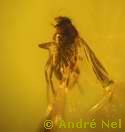Saturday, September 02, 2006
Book Review: 'The Origin of Mind: Evolution of Brain, Cognition, and General Intelligence'
Book Review from the American Journal of Psychiatry: "The Origin of Mind: Evolution of Brain, Cognition, and General Intelligence"
David Geary's The Origin of Mind is a remarkable book. As suggested by its subtitle, it ambitiously addresses many of the oldest questions of science (and society): How does one define intelligence? Is intelligence a biologically meaningful concept? What neurobiological mechanisms underlie not only intelligence but cognition in general? And, ultimately, what (if any) selective pressures shaped the evolution of the human brain? These are profound questions to ask and (to varying degrees in different chapters) Geary's work does an extraordinary job in answering them.
The book is organized around the author's "motivation to control" hypothesis - essentially, that the driving force of human evolution is an individual's ability to maintain control over the immediate environment. After a brief overview of natural and sexual selection, he focuses on the specific pressures likely to have contributed to hominid evolution - the most striking aspect of which is the exponential increase in both brain size and encephalization quotient that has taken place over the past 500,000 years. He argues that climatic forces were unlikely to have played a major role; rather, social pressures prevailed after relative ecological mastery was achieved.
-------
"The Origin of Mind: Evolution of Brain, Cognition, and General Intelligence" is currently appearing on the 'Featured Books' page of the Evolution Book Store: UK | US - or go directly to the Amazon webpage: UK | US
Featured Books: "The Handbook of Evolutionary Psychology" (Amazon UK | US)
and "Not By Genes Alone: How Culture Transformed Human Evolution" (Amazon UK | US)
Technorati: american, journal, psychiatry, book review, origin, mind, evolution, brain, cognition, general, intelligence, geary, book, science, concept, mechanisms, selective, pressures, human, motivation, control, hypothesis, environment, natural, sexual, selection, hominid, size, quotient, role, social, ecological, amazon, evolutionary, psychology, culture, genes, handbook
Add to: CiteUlike | Connotea | Del.icio.us | Digg | Furl | Newsvine | Reddit | Yahoo
Symposium: 'Macroevolution: Evolution above the Species Level' (AIBS, October 2006)
3rd Annual AIBS, BSCS, NESCent Evolution Science and Education Symposium
2006 Annual Meeting of the National Association of Biology Teachers - Albuquerque, New Mexico.
This year's theme: 'Macroevolution: Evolution above the Species Level'
In collaboration with the Biological Sciences Curriculum Study (BSCS) and the National Evolutionary Synthesis Center (NESCent), the American Institute of Biological Sciences (AIBS) is pleased to announce the 3rd annual evolution science and education symposium, 'Macroevolution: Evolution above the Species Level.' The one-day symposium will take place on October 14, 2006 in Albuquerque, New Mexico, at the annual meeting of the National Association of Biology Teachers (NABT).
--
Speakers include: Philip Gingerich, Scott Hodges, David Jablonski, Nicole King, Jeff Levinton, Nipam Patel
American Institute of Biological Sciences Special Symposia Webpage.
technorati tags: science, education, symposium, october, 2006, national, association, biology, teachers, albuquerque, new+mexico, macroevolution, evolution, species, level, biological, sciences, curriculum, study, evolutionary, synthesis, center, american, institute, annual, Philip, Gingerich, Scott, Hodges, David, Jablonski, Nicole, King, Jeff, Levinton, Nipam, Patel, speakers
Add to: CiteUlike | Connotea | Del.icio.us | Digg | Furl | Newsvine | Reddit | Yahoo
Friday, September 01, 2006
Fossil tooth expands reach of pandas (China)
From the Shanghai Daily: Scientists announced yesterday they found a giant panda fossil in central China, the first evidence pandas once roamed the area.
The giant panda tooth fossil was unearthed in June at the Lingjing historical site in the city of Xuchang, Henan Province, said Huang Wanbo, a researcher with the Chinese Academy of Sciences' Institute of Vertebrate Paleontology and Paleo-anthropology. It took nearly two months of painstaking analysis to identify the fossil.
Huang said the tooth is almost circular and comes from the right side of the giant panda's lower jaw. Huang believes the panda had a large area of mastication - about two millimeters long and two millimeters wide. The tooth enamel is damaged.
'These protuberances can not be found on the teeth of other bear species. They were formed because the giant panda was gnawing on bamboo,' Huang said.
-------
An earlier (and shorter) report appeared in India's The Hindu.
Books on Dinosaurs from the Science and Evolution Bookshop: UK | US
Books on Paleontology from the Science and Evolution Bookshop: UK | US
technorati tags: shanghai, daily, giant+panda, fossil, china, panda, henan, province, chinese, academy, sciences, institute, vertebrate, paleontology, paleo, anthropology, tooth, jaw, enamel, bear, species, bamboo, india, the+hindu
Add to: CiteUlike | Connotea | Del.icio.us | Digg | Furl | Newsvine | Reddit | Yahoo
Researchers Provide Evidence of How Proteins Fold
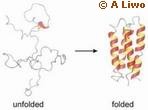 Experimental evidence provided by a Cornell researcher and colleagues at the Scripps Research Institute in La Jolla, California, support a long-held theory of how and where proteins fold to create their characteristic shapes and biological functions.
Experimental evidence provided by a Cornell researcher and colleagues at the Scripps Research Institute in La Jolla, California, support a long-held theory of how and where proteins fold to create their characteristic shapes and biological functions.
The theory proposes that proteins start to fold in specific places along an amino acid chain (called a polypeptide chain) that contains non-polar groups, or groups of molecules without a charge, and continue to fold by aggregation, i.e., as several individuals of these non-polar groupings combine. Using the same principle that separates oil and water, these molecules are hydrophobic - they avoid water and associate with each other.
--
Based on the Proceedings of the National Academy of Sciences (PNAS) paper "The role of hydrophobic interactions in initiation and propagation of protein folding" (Abstract).
technorati tags: cornell, scripps, research, institute, la+jolla, california, theory, proteins, fold, amino, acid, chain, polypeptide, non, polar, molecules, aggregation, hydrophobic, water, oil, proceedings, national, academy, sciences, pnas, protein, folding
Add to: CiteUlike | Connotea | Del.icio.us | Digg | Furl | Newsvine | Reddit | Yahoo
Re: 'Fossils of new dino species found (Titanosaur 'Maxakalisaurus topai')' - Video now available
 In an update to an entry made on Tuesday, August 29, 2006 (appended below) MSNBC carry virtually the same article as Aljazeera but also include a short video - click here (nb the video appears to only play in IE6+)
In an update to an entry made on Tuesday, August 29, 2006 (appended below) MSNBC carry virtually the same article as Aljazeera but also include a short video - click here (nb the video appears to only play in IE6+)
Aljazeera Science News Report: Rio de Janeiro, Brazil - Paleontologists have discovered a new giant dinosaur species based on fossilised fragments of the herbivorous reptile that lived 80 million years ago.
The Maxakalisaurus topai, of the Titanosauria group, was 13 metres long and weighed about nine tonnes.
It had a large body, long tail and neck with a relatively small head.
...The fossils date back to the Late Cretaceous period...
...The name of the species, Maxakalisaurus topai, derives from an Indian tribe, Maxakali, which lives in the area. Topa is a divinity that the tribe worships. [Titanosaur]
Alternative News Report from The Times of India
technorati tags: aljazeera, news, report, rio+de+janeiro, brazil, titanosaur, giant, dinosaur, species, herbivorous, reptile, cretaceous, period, indian, tribe, the+times, india, msnbc, video
Add to: CiteUlike | Connotea | Del.icio.us | Digg | Furl | Newsvine | Reddit | Yahoo
Evolution of Old World fruit flies on three continents mirrors climate change
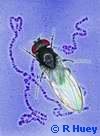 Evolution of Old World fruit flies on three continents mirrors climate change:
Evolution of Old World fruit flies on three continents mirrors climate change:
Fast-warming climate appears to be triggering genetic changes in a species of fruit fly that is native to Europe and was introduced into North and South America about 25 years ago.
"This is a clear signal on three different continents that climate change is occurring, and that genetic change is going along with it," said Raymond Huey, a University of Washington biology professor who is co-author of a paper describing the findings, published Aug. 31 in Science Express, the online edition of the journal Science.
The research deals with an Old World fruit fly species called Drosophila subobscura, which originally ranged from the Mediterranean Sea to Scandinavia. European biologists who studied the insect's genetic makeup more than 40 years ago noted that sections of chromosomes were inverted, something like taking part of a bar code from a consumer product and flipping it backwards. The biologists found that the frequency of particular inversions was correlated with the latitude where a given insect was found. Inversions that were common in the north were uncommon in the south, and vice versa.
--
Based on "Global Genetic Change Tracks Global Climate Warming in Drosophila subobscura" (Abstract)
Update Monday, September 4, 2006: The Washington Post's 'Science Notebook' also features an article on the above paper: "Fly's Evolution Tied to Warming" (scroll down the page).
technorati tags: drosophila, fruit-fly, evolution, old, world, continents, climate+change, climate, genetic, species, native, europe, north, south, america, university, washington, science, express, journal, research, mediterranean, sea, scandinavia, insect, chromosomes, inverted, bar+code, latitude, inversions, washington+post
Add to: CiteUlike | Connotea | Del.icio.us | Digg | Furl | Newsvine | Reddit | Yahoo
Re: 'Scientists Reverse Evolution, Reconstruct Ancient Gene' - Video now available
In an update to an entry made on Tuesday, August 08, 2006 (appended below) a short video featuring Mario Capecchi commenting on his work is now available at this page.
Scientists Reverse Evolution, Reconstruct Ancient Gene
Scientists Reverse Evolution, Reconstruct Ancient Gene: University of Utah scientists have shown how evolution works by reversing the process, reconstructing a 530-million-year-old gene by combining key portions of two modern mouse genes that descended from the archaic gene.
"It provides further evidence at the molecular level of how evolution has occurred and is occurring, and thus makes the process less mysterious," says Mario Capecchi, distinguished professor and co-chairman of human genetics at the University of Utah School of Medicine and an investigator with the Howard Hughes Medical Institute.
"We've shown some of the elements involved in the process of evolution by reversing this process and reconstructing a gene that later became two genes," he adds.
The study by Capecchi and postdoctoral fellow Petr Tvrdik was set for publication Monday, Aug. 7 in the August 2006 issue of the journal Developmental Cell (Abstract).
technorati tags: university, utah, evolution, reverse, genes, mouse, archaic, molecular, process, medicine, howard+hughes, institute, journal, developmental, cell, video
Add to: CiteUlike | Connotea | Del.icio.us | Digg | Furl | Newsvine | Reddit | Yahoo
Interested in Evolutionary Psychology?
An invitation from the Moderator of the Evolutionary Psychology Egroup to apply for free membership. From the Front Page:
Evolutionary psychology is an approach to psychology, in which knowledge and principles from evolutionary biology are put to use in research on the structure of the human mind.
A review of the evolutionary psychology group appeared in Salon Magazine.
The Human Nature Daily Review is a guide to recent developments in brain, behaviour and evolution. [behavior]
technorati tags: evolutionary+psychology, evolutionary, psychology, biology, structure, human, mind, salon, magazine, nature, brain, behavior, behaviour, evolution
Add to: CiteUlike | Connotea | Del.icio.us | Digg | Furl | Newsvine | Reddit | Yahoo
Thursday, August 31, 2006
Baby Rats Born From Mice
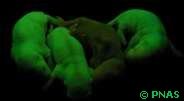 From National Geographic News: Rat sperm cells grown in mouse testicles have been used to successfully produce healthy baby rats, scientists say.
From National Geographic News: Rat sperm cells grown in mouse testicles have been used to successfully produce healthy baby rats, scientists say.
The research proves a concept first envisioned a decade ago: that functional sperm cells from many types of animals can be produced in small surrogate fathers of a different species.
The finding has implications for species conservation as well as farming and agriculture.
...Frozen sperm stem cells could be used to fertilize eggs of endangered species or to create genetically modified organisms more easily.
--
The above is based on the Proceedings of the National Academy of Sciences (PNAS) paper "Rats produced by interspecies spermatogonial transplantation in mice and in vitro microinsemination" (Abstract)
A short article is also carried by The Times of India (loc. Gurgaon, Haryana): "Twist in the tale: When mice beget rats"
technorati tags: national+geographic, news, rat, sperm, cells, mouse, testicles, baby, rats, research, animals, surrogate, fathers, species, different, conservation, farming, agriculture, frozen, stem, fertilize, eggs, endangered, genetically+modified, organisms, proceedings, national, academy, sciences, pnas, mice, the+times, india, gurgaon, haryana
Add to: CiteUlike | Connotea | Del.icio.us | Digg | Furl | Newsvine | Reddit | Yahoo
In a technical tour de force, Salk scientists take a global view of the epigenome
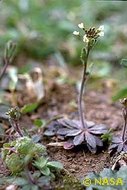 A collaboration between researchers at the Salk Institute for Biological Studies and the University of California at Los Angeles captured the genome-wide DNA methylation pattern of the plant Arabidopsis thaliana - the 'laboratory rat' of the plant world - in one big sweep.
A collaboration between researchers at the Salk Institute for Biological Studies and the University of California at Los Angeles captured the genome-wide DNA methylation pattern of the plant Arabidopsis thaliana - the 'laboratory rat' of the plant world - in one big sweep.
'In a single experiment we recapitulated 20 years worth of anecdotal findings and then some,' says senior author Joseph Ecker, Ph.D., a professor in the Salk Institute's Plant Biology Laboratory. 'Previously, only a hand full of plant genes were known to be regulated by methylation. In addition to those, we found hundreds of others.'
These technological innovations, pioneered by Ecker's team and that of Steve Jacobsen, Ph.D., a Howard Hughes Medical Institute investigator at UCLA, should have broad impact on the analysis of the human genome, stem cell biology and therapeutic cloning. Their findings will appear in a forthcoming issue of Cell.
Our view of heredity has largely been written in the language of DNA, but recent discoveries in a field known as epigenetics - the study of heritable changes in gene function that occur without changing the letters of the DNA alphabet - show that how a cell 'reads' those letters is critical. [epigenome, cells]
--
The Cell paper referred to above, "Genome-wide High-Resolution Mapping and Functional Analysis of DNA Methylation in Arabidopsis", is (currently) open access: Abstract | Full Text | Pdf
technorati tags: arabidopsis, epigenome, salk, institute, university, california, los+angeles, genome, wide, dna, methylation, pattern, plant, biology, genes, laboratory, howard+hughes, medical, investigator, ucla, stem, cell, cloning, cells, heredity, epigenetics
Add to: CiteUlike | Connotea | Del.icio.us | Digg | Furl | Newsvine | Reddit | Yahoo
There is a little Neanderthal in a lot of us (Telegraph, UK)
The Telegraph (UK): People who have large noses, a stocky build and a beetle brow may indeed be a little Neanderthal, according to a genetic study. But the good news is that other research concludes that Neanderthals were much more like us than previously thought.
People of European descent may be five per cent Neanderthal, according to a study published in the journal PLoS Genetics, which suggests we all have a sprinkling of archaic DNA in our genes.
"Instead of a population that left Africa 100,000 years ago and replaced all other archaic human groups, we propose that this population interacted with another population that had been in Europe for much longer, maybe 400,000 years," says Dr Vincent Plagnol, of the University of Southern California, who with Dr Jeffrey Wall analysed 135 different regions of the human genetic code. [Neandertal]
-------
The open access PLoS Genetics paper mentioned above is "Possible Ancestral Structure in Human Populations".
The Telegraph also refers to "Analysis of Aurignacian interstratification at the Chatelperronian-type site and implications for the behavioral modernity of Neandertals" (Abstract - direct link; blog entry here).
A summary of the Telegraph article also appears here in the Middle East Times (loc. Cairo, Egypt).
Books on Neanderthals from the Science and Evolution Bookshop: UK | US
Books on Human Origins from the Science and Evolution Bookshop: UK | US
technorati tags: the+telegraph, uk, beetle, brow, neanderthal, neandertal, genetic, study, european, descent, journal, plos+genetics, archaic, dna, genes, population, africa, europe, university, southern, california, code, middle+east, times, cairo, egypt
Add to: CiteUlike | Connotea | Del.icio.us | Digg | Furl | Newsvine | Reddit | Yahoo
Stolen dinosaur fossils recovered (UK)
 From BBC News (UK): Stolen fossilised dinosaur footprints, 200 million years old and from a protected site, have been found after being advertised on eBay.
From BBC News (UK): Stolen fossilised dinosaur footprints, 200 million years old and from a protected site, have been found after being advertised on eBay.
The three-toed prints, from coastline near Barry in the Vale of Glamorgan, had been offered for sale online and in a shop at Lyme Regis in Dorset.
The Countryside Council for Wales (CCW) realised they could have come only from the Bendrick Rock site.
A man described as a local amateur geologist has been cautioned by police.
technorati tags: bbc, news, stolen, fossilized, dinosaur, footprints, tracks, protected, site, ebay, barry, vale, glamorgan, wales, lyme+regis, dorset, ccw, bendrick, rock, police
Add to: CiteUlike | Connotea | Del.icio.us | Digg | Furl | Newsvine | Reddit | Yahoo
Wednesday, August 30, 2006
Evolutionary biology reappears on federal grant list
In an update to "US Department of Education 'overlooks' evolution" (direct link, posted Thursday, August 24, 2006; blog entry appended below) the New Scientist now reports:
Evolutionary biology, mysteriously missing from the list of undergraduate subjects eligible for a US federal grant, has been reinstated after a flurry of protest.
David Dunn of the Department of Education says its absence was the result of a misunderstanding. 'As soon as the omission came to our attention, we took steps to correct it.' However, the incident has left pro-evolution campaigners wondering whether evolutionary biology was deliberately left out by people who find Darwinian evolution at odds with their religious beliefs.
US Department of Education 'overlooks' evolution
The New Scientist: Evolutionary biology is mysteriously missing from the list of undergraduate subjects eligible for a US federal grant.
The department of education claims the omission is simply a mistake and insists that US students taking evolutionary biology majors are eligible for the grants. However, the incident has left pro-evolution campaigners wondering whether evolutionary biology was deliberately eliminated from the list by people who find Darwinian evolution impossible to reconcile with their own religious beliefs.
"I have reason to believe there is a serious problem here," physicist Lawrence Krauss of Case Western Reserve University in Cleveland, Ohio, told New Scientist.
technorati tags: new, scientist, evolutionary, biology, missing, undergraduate, subjects, us, federal, grant, department, education, omission, students, evolution, darwinian, religious, beliefs, case, western, reserve, university, cleveland, ohio
Add to: CiteUlike | Connotea | Del.icio.us | Digg | Furl | Newsvine | Reddit | Yahoo
On Point : Religion's Evolutionary Origins (Audio - Dennett)
Wbur - Boston's NPR News Source.
Aired - Wednesday, August 30, 2006 11-12PM ET.
On Point: The urge is so strong, most people don't fight it. In the presence of religion and religious icons - churches, temples, altars, scripture, holy relics from the Ganges riverbank to Rome - most people become reverent. Not Daniel Dennett.
Dennett is a philosopher on a mission. His mission is to break religion itself open to scientific inquiry, to 'break the spell,' in his words, of faith.
Dennett's conclusion is that religion is not miraculous or supernatural, but a product of nature itself -- of Darwinian evolution, like the finch's beak or the opposable thumb. If that sounds like sacrilege, maybe it is.
Hear about the evolutionary theory of religion.
Guests:
Professor Daniel C. Dennett, Center for Cognitive Studies, Tufts University (Author of "Breaking the Spell: Religion as a Natural Phenomenon" - currently appearing on the 'Featured Books' page of the Evolution Book Store: UK | US or go directly to Amazon: UK | US
Stephen Pope, Professor of Theology, Boston College.
--------
The 'Listen To Show' link is on the right-hand side of the above webpage. A number of listening options are given - Windows Media Player, Quicktime, Real Player, etc. - but at the time of writing the recording begins at different points in the program depending upon which one you chose (maybe Wbur haven't quite ironed out all the bugs yet!). [Audio]
technorati tags: wbur, boston, news, source, on+point, religion, religious, icons, churches, temples, altars, scripture, holy, relics, ganges, rome, daniel, dennett, philosopher, scientific, inquiry, breaking, spell, faith, miraculous, supernatural, nature, darwinian, evolution, finch, beak, audio, sacrilege, evolutionary, theory, stephen, pope, theology, college, tufts, university, windows, media, player, quicktime, real+player
Add to: CiteUlike | Connotea | Del.icio.us | Digg | Furl | Newsvine | Reddit | Yahoo
Ancient Raptors Likely Feasted On Early Man, Study Suggests
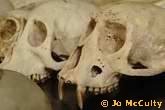 Ohio State University (OSU): Columbus - A new study suggests that prehistoric birds of prey made meals out of some of our earliest human ancestors.
Ohio State University (OSU): Columbus - A new study suggests that prehistoric birds of prey made meals out of some of our earliest human ancestors.
Researchers drew this conclusion after studying more than 600 bones from modern-day monkeys. They had collected the bones from beneath the nests of African crowned eagles in the Ivory Coast's Tai rainforest...
...Punctures and scratches on many of the monkey skulls have led some researchers to rethink which animals may have preyed on our human ancestors, said W. Scott McGraw, the study's lead author and an associate professor of anthropology at Ohio State University...
...Archaeologists discovered the skull of a 3 1/2 year old ape-like child in a cave in South Africa in 1924. Researchers believed this child, called the Taung child (Australopithecus africanus), had been killed by a predatory cat. But McGraw said that puncture marks on the monkey skulls he examined closely resemble those found on the skull of the Taung child...
--
The above is based on the American Journal of Physical Anthropology paper "Primate remains from African crowned eagle (Stephanoaetus coronatus) nests in Ivory Coast's Tai Forest: Implications for primate predation and early hominid taphonomy in South Africa" (Abstract)
Somewhat later than everyone else, The Washington Post's 'Science Notebook' for Monday, 11th September 2006, is also carrying an article on this topic titled "Human Ancestors as Bird Food"
technorati tags: ohio, state, university, columbus, prehistoric, human, ancestors, bones, modern, monkeys, african, crowned, eagles, ivory+coast, tai, rainforest, skull, study, anthropology, ape, child, taung, predatory, cat, puncture, marks, american, journal, physical, hominid
Add to: CiteUlike | Connotea | Del.icio.us | Digg | Furl | Newsvine | Reddit | Yahoo
Kodak technology pictures dinosaur: The Leonardo Project
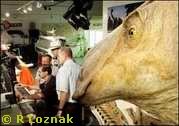 Rochester, New York - In the language of science, he's a Brachylophosaurus canadensis ("short crested lizard,"). To the engineers at Eastman Kodak Co., he is something else entirely: A unique opportunity to test new digital imaging technology with the potential to solve some the biggest mysteries of the physical world.
Rochester, New York - In the language of science, he's a Brachylophosaurus canadensis ("short crested lizard,"). To the engineers at Eastman Kodak Co., he is something else entirely: A unique opportunity to test new digital imaging technology with the potential to solve some the biggest mysteries of the physical world.
Kodak is a central part of the team examining and evaluating a perfectly preserved, complete dinosaur fossil recovered from the badlands of northern Montana more than six years ago.
Code-named Leonardo, the fossil is entombed in a 3-ton block of sandstone and is believed to be more than 77 million years old. The dinosaur's skeleton is covered in soft tissue, such as skin and scales, making it one of the most significant paleontological finds ever. [News]
--
See "The Leonardo Project" at the Kodak website (6 pages - links are in the left-hand sidebar) and "The Official website of the Leonardo Project" (from discovery to science to exhibit.)
Books on dinosaurs from the Science and Evolution Bookshop: UK | US
technorati tags: rochester, new+york, science, lizard, short, crested, eastman, kodak, digital, imaging, technology, dinosaur, fossil, badlands, montana, leonardo, sandstone, skeleton, soft+tissue, skin, scales, project, discovery, exhibit, news
Add to: CiteUlike | Connotea | Del.icio.us | Digg | Furl | Newsvine | Reddit | Yahoo
Tuesday, August 29, 2006
Amber find shows Amazon as biodiversity hotspot
In northern Peru, 15 to 12 million years ago, insects, mites and other arthropods became trapped in resin on tree trunks and branches. They were discovered, fossilized in amber, by an international team of paleontologists and geologists(1). This discovery is the first of its kind in western Amazonia, and it has enabled the researchers to show that high terrestrial biodiversity existed early on in the region, in a forest environment with a hot, humid climate. These findings have been published on line on the web site of the Proceedings of the National Academy of Sciences [1].
The amber, which is fossilized resin, comes from a single stratigraphic level dating from the middle Miocene (15 to 12 million years ago). It was discovered by the researchers on the banks of the Amazon during a field trip in the Iquitos area in 2004. The team, coordinated by Pierre-Olivier Antoine, from the Laboratory for Transfer Mechanisms in Geology (Laboratoire des mécanismes de transfert en géologie, CNRS/Université Toulouse 3/IRD), has for several years been exploring the sedimentary formations in this region, which is located at the foot of the Andes on the border of Brazil, Ecuador and Colombia. Their goal is to find out how the fauna and flora, environments and geography of western Amazonia have evolved over the past twenty million years under the influence of the uplift of the Andes. This is one of the goals of the Past Environments and Climates program (Environnements et climats du passé, ECLIPSE), a multidisciplinary program run by INSU-CNRS.
Today, Amazonia is the area with the greatest terrestrial biodiversity in the world, but very little is known about the past of this remote and little-explored region, which was totally cut off from the rest of the world 12 to 15 million years ago (the Panama isthmian strait closed up only 3.5 million years ago). The insect and arachnid fossils found by the team are the first terrestrial arthropods ever discovered in this part of the world. Amber from Amazonia contains unusually high amounts of animals and plants. At least 13 species of insect and 3 species of mite have already been identified by André Nel, a paleoentomologist from the National Museum of Natural History (Muséum National d'Histoire Naturelle, MNHN) in Paris. For instance, the fossilized resin trapped several flies and mosquitoes, parasitic wasps, a beetle related to the ladybirds, a caddis fly (well-known to anglers), and so on. There is even a mite caught up in a spider's web.
A huge quantity of microfossils were trapped by the resin, including a wide range of bacteria, cyanobacteria, fungal spores, algae, and even a lichen and a pollen grain. The cell content of certain microfossils has been preserved, which means that it may be possible to access their DNA and attempt to reconstruct their phylogeny (i.e. their family tree). Thanks to this discovery, the researchers now know that 12 to 15 million years ago the region was a delta opening out into an inland sea surrounded by dense forest, with a climate that was already hot and very humid, and where it probably wouldn't have been much fun to live!
Source: The Centre National de la Recherche Scientifique (National Center for Scientific Research) PR "Discovery of fossil insects in amber from Amazonia" August 29 2006
-------
[1] Based on the PNAS paper:
Amber from western Amazonia reveals Neotropical diversity during the middle Miocene
Pierre-Olivier Antoine, Dario De Franceschi, John J. Flynn, André Nel , Patrice Baby, Mouloud Benammi, Ysabel Calderon, Nicolas Espurt, Anjali Goswami, and Rodolfo Salas-Gismondi
Published online before print September 1, 2006, 10.1073/pnas.0605801103
Tertiary insects and arachnids have been virtually unknown from the vast western Amazonian basin. We report here the discovery of amber from this region containing a diverse fossil arthropod fauna (13 hexapod families and 3 arachnid species) and abundant microfossil inclusions (pollen, spores, algae, and cyanophyceae). This unique fossil assemblage, recovered from middle Miocene deposits of northeastern Peru, greatly increases the known diversity of Cenozoic tropical-equatorial arthropods and microorganisms and provides insights into the biogeography and evolutionary history of modern Neotropical biota. It also strengthens evidence for the presence of more modern, high-diversity tropical rainforest ecosystems during the middle Miocene in western Amazonia.
-------
Related posts include:
"Evolutionary history of vespid wasps rewritten by New study"
"Honeybee : Open Access articles and video from Nature magazine ('Web focus')"
Add to: CiteUlike | Connotea | Del.icio.us | Digg | Furl | Newsvine | Reddit | Yahoo
Tetrahymena thermophila: What's Shaped Like A Pear And Has 2 Genomes? Check The Pond (Ciliate)
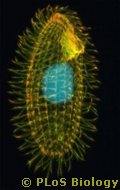 If you could peer microscopically into the closest freshwater pond, you'd hesitate before dipping a toe. Amid the murky water, you'd probably notice an oddly furry, pear-shaped organism gliding along - and gobbling up everything in its path.
If you could peer microscopically into the closest freshwater pond, you'd hesitate before dipping a toe. Amid the murky water, you'd probably notice an oddly furry, pear-shaped organism gliding along - and gobbling up everything in its path.
This tiny predator has a big name - Tetrahymena thermophila - and a big fan club among scientists, as a star organism for research into how cells work.
Scientists have now sequenced, assembled, and analyzed T. thermophila's macronuclear genome. Their work, reported in today's issue of Public Library of Science (PLoS) Biology, explains the organism's impressive versatility. Rather than dividing labor into several types of cells, as humans and other multicellular organisms do, T. thermophila divides its activities, either into different places inside a cell or by changing the cell over time. It is a master multi-tasker.
--
The open access PLoS Biology paper referred to above is "Macronuclear Genome Sequence of the Ciliate Tetrahymena thermophila, a Model Eukaryote"
technorati tags: tetrahymena+thermophila, freshwater, pond, organism, research, cells, work, macronuclear, genome, plos, biology, versatility, humans, multicellular, cell, genome, sequence, ciliate, model, eukaryote
Add to: CiteUlike | Connotea | Del.icio.us | Digg | Furl | Newsvine | Reddit | Yahoo
Manatee Bones Lead Stanford Scientist to New Insight on Evolution
 Most research professors spend their days writing grants, teaching and managing graduate students, so when Stanford's David Kingsley, PhD, ventured from his office to his lab, pulled out a scale and started weighing 114 pairs of manatee pelvic bones, it was a sign that something was afoot.
Most research professors spend their days writing grants, teaching and managing graduate students, so when Stanford's David Kingsley, PhD, ventured from his office to his lab, pulled out a scale and started weighing 114 pairs of manatee pelvic bones, it was a sign that something was afoot.
The results of Kingsley's efforts make his departure from the routine worthwhile. He found that in almost every case, the left pelvic bone outweighed the right. Although seemingly trivial in difference - the average left pelvic bone is a mere 10 percent larger than its right-side partner - that difference carries big weight in evolutionary significance. It suggests that mutations in the same gene may be responsible for the evolution of leglessness in animals as distantly related as 1,000-pound manatees in Florida and fish smaller than an index finger living in lakes and streams around the world.
"It's striking that evolution might use the same mechanism over and over," said Kingsley, professor of developmental biology at the Stanford University School of Medicine and a Howard Hughes Medical Institute investigator. His study will appear in the Aug. 28 advance online issue of the Proceedings of the National Academy of Sciences.
--
The paper didn't actually appear until the 31st (but never mind!): "Parallel genetic origins of pelvic reduction in vertebrates" (Abstract).
Today's New York Times (may require free registration) is also carrying a three-page article on manatees:"Sleek? Well, No. Complex? Yes, Indeed."
technorati tags: research, stanford, manatee, pelvic, bones, evolutionary, florida, fish, lakes, streams, evolution, mechanism, developmental, kingsley, university, school, medicine, howard+hughes, medical, institute, proceedings, national, academy, sciences, pnas, new+york+times, manatees, complex
Add to: CiteUlike | Connotea | Del.icio.us | Digg | Furl | Newsvine | Reddit | Yahoo
Fossils of new dino species found (Titanosaur 'Maxakalisaurus topai')
UPDATE 16th September: Aljazeera was chosen for this report to add 'variety' but the link is proving to be unreliable. If it doesn't work try "Brazilians unearth new monster dino species" (The Register, UK), "New dinosaur rears its long neck in Brazil" (People's Daily, China), or The Times of India's "Scientists unveil dinosaur fossil in Brazil"
Aljazeera Science News Report: Rio de Janeiro, Brazil - Paleontologists have discovered a new giant dinosaur species based on fossilised fragments of the herbivorous reptile that lived 80 million years ago.
The Maxakalisaurus topai, of the Titanosauria group, was 13 metres long and weighed about nine tonnes.
It had a large body, long tail and neck with a relatively small head.
..The fossils date back to the Late Cretaceous period..
..The name of the species, Maxakalisaurus topai, derives from an Indian tribe, Maxakali, which lives in the area. Topa is a divinity that the tribe worships. [Titanosaur]
Alternative News Report from The Times of India
technorati tags: aljazeera, news, report, rio+de+janeiro, brazil, titanosaur, giant, dinosaur, species, herbivorous, reptile, cretaceous, period, indian, tribe, the+times, india
Add to: CiteUlike | Connotea | Del.icio.us | Digg | Furl | Newsvine | Reddit | Yahoo
Monday, August 28, 2006
Australia: Victorian fish fossil fills ancient gap
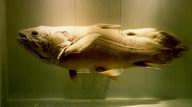 Australia: The oldest known fossil coelacanth has just been described by Macquarie University (New South Wales) researchers in the international journal Biology Letters, in conjunction with colleagues in Victoria and Paris.
Australia: The oldest known fossil coelacanth has just been described by Macquarie University (New South Wales) researchers in the international journal Biology Letters, in conjunction with colleagues in Victoria and Paris.
The coelacanth ("see-la-kanth") is a "living fossil" fish with "proto legs" that pre-dates the dinosaurs by millions of years. It was once thought to have gone extinct with them, 65 million years ago, but was rediscovered living in the Indian Ocean in 1938.
This new coelacanth fossil was collected by Professor John Talent of the Macquarie University Centre for Ecostratigraphy and Palaeobiology from Early Devonian rocks in Victoria in the 1970s. At nearly 400 million years old, it is much older than previously known coelacanth fossils. [NSW]
--
The Biology Letters paper is "Oldest coelacanth, from the Early Devonian of Australia" (Abstract)
technorati tags: australia, macquarie, university, new+south+wales, nsw, journal, biology, letters, victoria, paris, fossil, coelacanth, dinosaurs, indian, ocean, talent, ecostratigraphy, palaeobiology, early, devonian, rocks, fossils, paleobiology
Add to: CiteUlike | Connotea | Del.icio.us | Digg | Furl | Newsvine | Reddit | Yahoo
Pope Benedict XVI prepares to embrace theory of intelligent design
The Guardian (UK): Philosophers, scientists and other intellectuals close to Pope Benedict XVI will gather at his summer palace outside Rome this week for intensive discussions that could herald a fundamental shift in the Vatican's view of evolution.
There have been growing signs the Pope is considering aligning his church more closely with the theory of 'intelligent design' taught in some US states. Advocates of the theory argue that some features of the universe and nature are so complex that they must have been designed by a higher intelligence. Critics say it is a disguise for creationism.
...In 1996, in what was seen as a capitulation to scientific orthodoxy, John Paul II said Darwin's theories were "more than a hypothesis"... [Roman Catholic]
technorati tags: the+guardian, uk, philosophers, scientists, intellectuals, pope, benedict, benedict+XVI, summer, palace, rome, vatican, evolution, church, roman+catholic, theory, intelligent+design, us, states, universe, nature, complex, higher, intelligence, critics, creationism, john+paul+II, darwin, hypothesis
Add to: CiteUlike | Connotea | Del.icio.us | Digg | Furl | Newsvine | Reddit | Yahoo
Sunday, August 27, 2006
Study finds how organs monitor themselves during early development
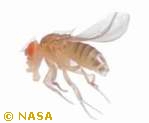 New York, August 27, 2006 - How are you? In biological terms this question could involve a feedback loop that lets the body check in on itself and then act on that information. Although feedback loops are essential and they abound in biology, they aren't well understood. Feedback loops enable an organ such as the liver to detect if it is injured, ascertain if it is growing and developing normally, and if it needs to regenerate itself. When such loops derail, cancer and other diseases can arise.
New York, August 27, 2006 - How are you? In biological terms this question could involve a feedback loop that lets the body check in on itself and then act on that information. Although feedback loops are essential and they abound in biology, they aren't well understood. Feedback loops enable an organ such as the liver to detect if it is injured, ascertain if it is growing and developing normally, and if it needs to regenerate itself. When such loops derail, cancer and other diseases can arise.
Scientists at NYU School of Medicine have unraveled the signals in a feedback loop governing ovarian development. This work has been several years in the making and is being published on 27 August in the Advance Online issue of the journal Nature.
'I think our study has indeed important implications that extend beyond understanding of how a gonad such as the ovary develops,' explains Dr. Ruth Lehmann, Ph.D., Julius Raynes Professor of Developmental Genetics and Howard Hughes Medical Investigator. 'In every organ, may it be a gonad, a liver, or a thymus, different tissues contribute to the organ, and the growth of the different tissues has to be coordinated both during normal development and during regeneration.' [University, Drosophila melanogaster, fruit-fly]
--
The Nature paper is "Soma-germline interactions coordinate homeostasis and growth in the Drosophila gonad" (Abstract)
technorati tags: new+york, feedback, loop, body, biology, organ, liver, diseases, nyu, school, medicine, journal, nature, ovary, development, genetics, gonad, thymus, tissues, growth, soma, germline, homeostasis, drosophila, melanogaster, fruit-fly, university
Add to: CiteUlike | Connotea | Del.icio.us | Digg | Furl | Newsvine | Reddit | Yahoo
Researchers provide first evidence for learning mechanism
Finally confirming a fact that remained unproven for more than 30 years, researchers at MIT's Picower Institute for Learning and Memory report in the Aug. 25 issue of Science that certain key connections among neurons get stronger when we learn.
"We show what everyone has always believed: LTP (long-term potentiation) is indeed induced in the hippocampus when learning occurs," said Mark F. Bear, Picower Professor of Neuroscience. "This is a big deal for neuroscientists because such evidence has been absent for the 30-plus years we have known about LTP."
The findings described in the Bear paper and in a second, separate paper in the same issue of the journal Science "substantially advance the case for LTP as a neural mechanism for memory," wrote Tim Bliss of the MRC National Institute for Medical Research in the UK, Graham Collingridge of the University of Bristol, and Serge Laroche of the Universite Paris Sud in a commentary on the work. [Massachusetts Institute of Technology]
--
The two Science papers referred to are:
"Learning Induces Long-Term Potentiation in the Hippocampus" (Abstract)
"Storage of Spatial Information by the Maintenance Mechanism of LTP" (Abstract)
technorati tags: massachusetts, institute, technology, mit, picower, learning, memory, journal, science, neurons, ltp, long-term, potentiation, hippocampus, neuroscience, bear, professor, evidence, neural, mechanism, national, medical, research, uk, university, bristol, paris, sud, universite
Add to: CiteUlike | Connotea | Del.icio.us | Digg | Furl | Newsvine | Reddit | Yahoo
Trust your instincts: The conscious mind isn't much use in making hard decisions
 Do you really need that flat-pack wardrobe or would the foldaway futon be a better buy? Why not have lunch and think about it? Then you might need to choose between pickled herring or Swedish meatballs. Everywhere we are confronted with difficult choices. In Luke Rhinehart's novel The Dice Man, the eponymous hero makes all his decisions by rolling a dice. Few of us would trust to a life ruled by chance, so we tend to think carefully about the complex decisions (the wardrobe or the futon) but are content to trust our instincts with the simpler things (meatballs or herring). New research by Ap Dijksterhuis and his colleagues at the University of Amsterdam suggests that we would be better off thinking about the simple choices, and leaving the life-changing decisions to our unconscious mind.
Do you really need that flat-pack wardrobe or would the foldaway futon be a better buy? Why not have lunch and think about it? Then you might need to choose between pickled herring or Swedish meatballs. Everywhere we are confronted with difficult choices. In Luke Rhinehart's novel The Dice Man, the eponymous hero makes all his decisions by rolling a dice. Few of us would trust to a life ruled by chance, so we tend to think carefully about the complex decisions (the wardrobe or the futon) but are content to trust our instincts with the simpler things (meatballs or herring). New research by Ap Dijksterhuis and his colleagues at the University of Amsterdam suggests that we would be better off thinking about the simple choices, and leaving the life-changing decisions to our unconscious mind.
--
See "On Making the Right Choice: The Deliberation-Without-Attention Effect" Abstract | Full Text (pdf)
technorati tags: choices, rhinehart, dice, man, chance, complex, decisions, instincts, research, university, amsterdam, life, changing, unconscious, mind, deliberation, attention, effect
Add to: CiteUlike | Connotea | Del.icio.us | Digg | Furl | Newsvine | Reddit | Yahoo
